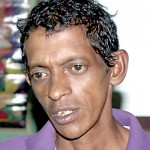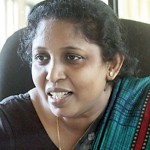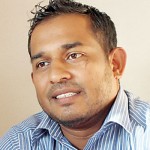News
Lanka at the tipping point
It is late evening and the rain is pouring outside. Nishantha Jayalath, 43, is playing with his two little children while listening to a Sinhala song. From his house we can faintly smell the stench from the garbage mountains nearby.
Mr. Jayalath is living within 500m of the Karadiyana Waste Management Facility (KWMF). When he purchased the plot of land 10 years ago, Mr. Jayalath did not know what he was signing on for.

Big stink: The Karadiyana Waste Management Facility. Pix by Anuradha Bandara
“The smell is unbearable and with the rain it is worse. My two sons, both under 10, fall sick frequently. The doctor diagnosed them with respiratory distress. He said that this is caused by the chemicals that ooze out of the waste disposal,” said Mr Jayalath, who is employed at the Education Ministry.
His story is one of a thousand that have emerged as a result of the increasingly huge volumes of garbage production in the country.
Unlike other countries in South Asia, Sri Lanka is able to brag about its “infrastructure development” following a 30-year ethnic conflict. This year’s United Nations Human Development Index placed Sri Lanka in 73rd position from 187 countries – above all other South Asian nations.
With development, increasing consumption by the public is inevitable but the question that lingers is whether Sri Lanka is heading in the right direction.
Take a minute to picture this. It is an ordinary day. You make a quick stop at a bakery to buy a cake. This cake is wrapped in a clingfilm, put into a box and then into a plastic bag, or two, for your convenience. But how many people stop to think where all the wrappers and all other waste go?
KWMF is one of the two major garbage tips in the Western Province, the other being Kolonnawa. Daily, 600-650 metric tonnes of garbage from eight divisions including Moratuwa, Boralesgamuwa, Kesbewa and Maharagama are ditched out of sight here. The Central Environment Authority (CEA) said neither of these sites is authorised but it monitors them.
 More than 1300 metric tonnes (MT) of garbage are produced daily around the country, 750MT from the Western Province.
More than 1300 metric tonnes (MT) of garbage are produced daily around the country, 750MT from the Western Province.
Following a decade-long list of complaints, petitions and protests by residents living near garbage tips Cabinet gave approval in August for a dump to be established in Aruakkalu, Puttalam, at a cost of Rs. 14 billion.
Three trains loaded with solid waste will run daily from the Western Province to the new site, where the garbage will be dumped as so-called “sanitary landfill”, where it is sprayed with pesticides and layered with sand to prevent animals from getting at it.
“Puttalam is not the solution to this problem. We cannot pollute Aruakkalu just because Western Province fails to manage waste. Think about the cost that will go to transport all the collected garbage from the Western Province to Puttalam which is 120km away,” said Hemantha Withanage, Executive Director of Centre for Environmental Justice.
What the country needs is a productive solid-waste-recycle system because waste is a valuable resource, Mr. Withanage said, pointing to the three-R system (reduce, reuse and recycle) or zero waste system.
He said dumping waste somewhere or claiming to make energy out of it was not an efficient way of handling the country’s garbage. Since our garbage is moist it is necessary to incur the cost of drying it in order to make energy.
The place to start, Mr. Withanage says, is home.
“People’s behavioural patterns should change: they should take responsibility for the garbage produced in their homes,” he said; a great change could be made by separating domestic garbage.
The environmental activist warned about the hazards in e-waste: mercury-laden products such as CFLs (compact fluorescent lamps), computer

Nishantha Jayalath
parts and thermometers end up in sanitary landfill, and making compost from mercury-mixed waste can be harmful.
Mr. Withanage said the state should introduce an efficient system such as Extended Producer Responsibility where companies would be responsible for taking back used equipment that they had sold.
The CEA has identified that only a third of collected waste is recycled. Two divisions in the authority that are constructively looking for a change in waste management are the E-Waste Management and Plastic Waste Management units.
During National Waste Electrical and Electronic Equipment Management week in late May-June the CEA collected 312MT of e-waste.
“E-waste is a problem to the country and cannot be recycled easily because it contains mercury. Our task is to manage this before they contaminate water resources or pollute the environment.
“More than 30 companies in Sri Lanka have the licence to produce, store and manage these items,” said Deputy Director of the E-Waste Management Unit, Devika Vithanage.

Devika Vithanage
Of the 30, 19 have signed agreements with the CEA to collect and properly dispose of their used and unwanted products. Ms. Vithanage’s unit intends to conduct a survey of e-waste early next year to keep track of the process.
Some 6 per cent of total waste is plastic. This non-degradable substance pollutes the environment and harms animals and marine life.
Daily household generation of plastic and polythene in the country is 880MT and only 40 per cent of it is collected and recycled, with 30 per cent of this resold as finished product, often creating yet more plastic coverings for goods.
“We import 500,000MT of plastic and polythene annually to meet changing consumer patterns and urbanisation. A large amount of the imported plastic ends up in bodies of water or scattered around festive and recreational sites such as Adam’s Peak and the Dalada Maligawa. We are trying to minimise this,” said Bandula Sarath Kumara, Director of the CEA’s Plastic Waste Management Unit.
Most people, however, would just listen to the CEA’s awareness campaigns but not change their ways, he lamented.
“It is very hard to do this if the public is not willing to change,” Mr. Kumara said.
“The government allocated Rs. 80 million in 2013 to fund plastic management projects.
“We have supplied schools and government offices with four coloured bins and bags to separate waste as plastic, paper, glass and organic matter. We are trying to reduce the import of plastic as a raw material and recycle existing used plastic.”
Mr. Kumara said all districts had been instructed to collect garbage separately for the purpose of recycling, and to facilitate this a number of recycling and storage centres have been established in several districts.
Next year they hope to open up such centres in the Colombo Municipal Council area and in Sri Jayawardenapura Kotte. In 2016, two more centres will be set up in Jaffna and Trincomalee.
“Our project has proven to be successful and our target is to increase recycled plastic to 80 per cent by 2018. We need the help of the general public for this,” Mr. Kumara said.
Meanwhile a team at the KWMF has introduced a “Green City’ project in the facility in a bid to convert waste to energy. A compost site was started at the facility in mid-August in the hope of managing the 23 million MT of garbage that is dumped at Karadiyana.
The facility, neglected for more than a decade, is now seeing a transformation but the team is struggling to tackle the enormity of the waste problem.

Chamila Silva
KWMF Project Manager Chamila Silva said although all eight local authorities that dump garbage in the facility have been asked to separate their waste, not all are willing to do so.
“The chairpersons and governors of these areas should change their way of thinking. If they are not willing to change nor will the public,” Mr. Silva said adding that the Moratuwa Municipal Council had successfully adopted the separation procedure and was carrying out the project well.
| Kaduwela and Kandy connect with public to cope with waste
The Kaduwela and Kandy Municipal Councils are setting a good example in successful waste separation and management. Kandy MC, with the objective of working with the community, is providing financial incentives to households willing to adopt effective waste management, working in collaboration with other government officials such as samurdhi and environmental officers in its 45 grama niladhari divisions. “We have started to purchase solid waste such as plastic and paper from the public. Currently we pay Rs. 31 for a kilo of plastic and next year we hope to get a plastic crusher to recycle it. Following this we hope to pay more than Rs. 40 per kilo,” said the Public Health Inspector of the Kandy MC, Sanjeewa Herath. He said people would only co-operate if motivated to do so. “This is what we are doing. We collect this waste once a week and organic waste thrice a week. We have also introduced three-wheeler transportation to collect waste from areas without proper roads,” he said. Kaduwela MC Community Development Officer Lalith Nanayakkara said the council had set up a system where compost made from collected waste was sold at a nominal rate of Rs. 3 per kilo to farmers and families engaged in agriculture and gardening. The council had a strict policy of rejecting garbage that was not sorted. “We simply return the bag,” said Mr. Nanayakkara. “Waste is a resource but the public should work together with us to manage this well. We conduct educational campaigns to create awareness among the public. All local authorities can encourage people to make a change.” |

